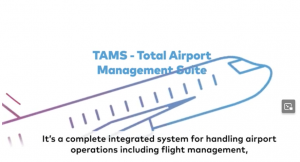Total Airport Management Suite (TAMS)
| Company | TAV Technologies |
|---|

Images
Airport operations have become increasingly complex, demanding higher efficiency and flawless passenger experiences. To meet these demands, the industry has embraced smart solutions and innovative approaches, such as collaborative decision making, resource optimization, self-service systems, and mobile platforms. However, integrating multiple airport solutions has posed challenges, prompting airport managers to adopt a holistic perspective. TAV Technologies has developed the Total Airport Management Suite (TAMS), a next-generation airport management solution, to address these challenges and enable efficient resource utilization and digitalization.
TAMS serves as a central platform for total airport management and consists of several modules that can operate independently, including:
- Flight Management System (FMS)
- Resource Management System (RMS)
- Airport Collaborative Decision Making (A-CDM)
- Slot Management (SLOT)
- Travel Document Authorization (TDAS)
- Commercial Management System (CMS)
- Flight Information Display System (FIDS)
- Ground Handling Suite (GHS)
- Capacity Planning System (CPS)
- Simulation/Airport Flow Management (SIM)
- Passenger Flow Management (PFM)
This modular structure allows TAMS to provide comprehensive solutions for flight management, resource allocation, capacity planning, commercial management, and collaborative decision-making.
The key benefits of TAMS include:
- Increased compliance rates: TAMS helps airports achieve higher compliance rates by streamlining operations and ensuring adherence to industry standards and regulations.
- Enhanced end-user satisfaction: With TAMS, airports can provide a seamless and efficient passenger experience, leading to improved satisfaction levels.
- Optimal resource utilization: The system enables efficient allocation and utilization of airport resources, maximizing operational efficiency and minimizing waste.
- Accurate operational predictions: By leveraging data and collaborative decision-making capabilities, TAMS allows airports to make accurate predictions about operational progress, facilitating proactive planning and management.
- Cost savings: TAMS reduces maintenance and support costs while enhancing operational efficiency, leading to significant cost savings for airport operators.
- Improved performance and stability: The system enhances the performance, stability, and speed of airport operations, ensuring smooth and reliable processes.
- Real-time access to information: TAMS provides stakeholders with real-time access to relevant and timely information, enabling informed decision-making and improved coordination.
- Seamless integration: TAMS integrates various airport processes into a unified and optimized architecture, promoting seamless operations and data collaboration.
- Holistic perspective: TAMS encourages airport managers to adopt a holistic perspective, considering the entire airport ecosystem and optimizing operations across different modules.
- Future readiness: TAMS is designed to embrace digitalization and adapt to evolving industry standards, ensuring airports remain future-ready and capable of meeting changing demands.
Through TAMS, airports can achieve seamless operations, efficient resource allocation, and enhanced collaboration among stakeholders. It represents a significant step forward in airport management, paving the way for further advancements and providing a solid foundation for future growth.














